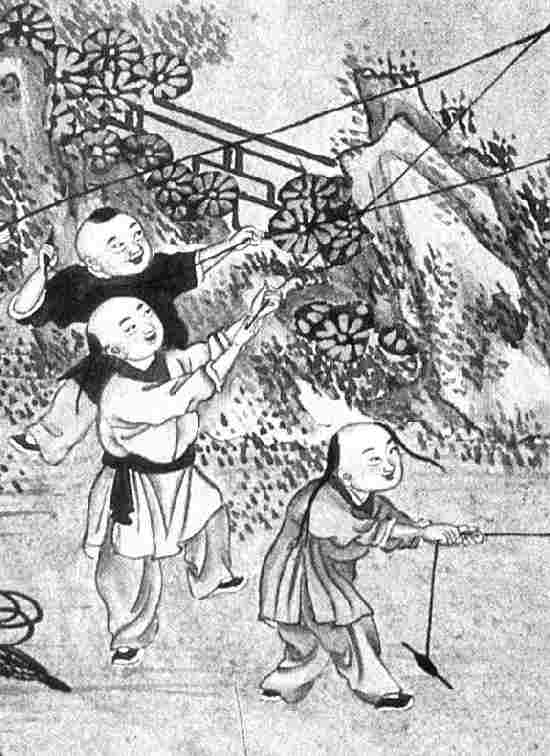
Ancirnt China: Clothing and Textiles

Figure 2.--These Chinese boys are flying a kite. Unfortunately we are not yet able to date the painting. Notably, the Chinese appear to ahve invented kiites some time about 500-400 BC. Notice both the loose fitting tunics and pajama-like pants as well as the destinctive hair styles. This paingting is much more recent.
|
|
The clothing of ancirnt China is a coimplicated topic. The various cultures and dynasties of ancient China great comoplicate any assessment. What is clear that as in other cultures, clothing and adirnment became a matter of social status. Clothing was a way people could exhibit their class standing. The fabric, color, and decorations on of the clothing indicated social position. People of higher classes dressed themselves and their families in expensive fine silks. While there were changes over time, there were also many constant threads. The wealthy, both men and women, wore long robes tied with a sash. People of lesser rank or children might wear shorter robes lookin more like tunics. One might note that robe-like garments were also worn in the West. This is probably a functional matter. Futted garments were more complicated to weave and thus more exoensive. Under the robes, the wealthy wore pajama-like trousers that were fitted tight at the ankles. This apparently varied over time. Note the boys here who wear pants not drawn in at the abkles (figure 1). The wealthy wore silk all year found, the weight of the garments, however, varied seaonlly. Chinese clothing was very colorful and least for the well-to-do tht could aford fine garments.
Men tied their hair in a knot covered which would be covered with a cloth or hat. Women had very different dstyles. They braided their hair into often elablorate creations. They twisted the braids and added often higly decorative pins and combs. Peasants who made up the grrat bulk of the population in contrast dressed plainly with a long shirt-like garment made of inexpensive fabrics like hemp fiber. They would also wear hats in pubic, inexpensive straw hats.
The Zhou dynasty developed formal laws about clothing, rules rhat would influence subsequent dynasties. This included laws and regulatuions about color, design, and adornment. The rules wee a matter addressed at thge highest level, indicating tge importance attached to dress. The emperor and court officials developed the rules. One of the most important was to reserve the color yellow exclusively for the emperor personal wear. (Justvas purple was reserved for the Roman emperor.) Green, red, white, and black developed as symbols for north, south, east, and west.
Chinese clothing was destinctive because if their cultural isolation from the other great river valley civilizations developing to the West. In addition to this isolation, for centuries the Chinese were the only civilization to have developed silk. It is considered to be the most luxurious fabrics. It is also one of the oldest. The Chinese developed before the Silk Road developed (27th century BC). It became obe of the most sought after Chinese product which of course is why the tenuous connection between East and West became known as the Silk Road. The Chinese attempted to maintain it as a state secret. It is produced from silkworm cocoons. People collected and unwound millions of cocoons to make silk thread. Hundreds of cocuns might go into even a small garment. We have noted a few images of children in Chinese art, but they are not always dated, making it difficult to assess changes over time. Most of the images we have noted show boys wearing lose tunics and pajamalike long trousers. We do not know precisely when this clothing style developed. We note that the fine clothes worn by the elite often had magnificent embroidery with important imagery.
HBC

Related Chronolgy Pages in the Boys' Historical Web Site
[The 1880s]
[The 1890s]
[The 1900s]
[The 1910s]
[The 1920s]
[The 1930s]
[The 1940s]
[The 1930s]
[The 1940s]
[The 1950s]
[The 1960s]
[The 1970s]
[The 1980s]
Related Style Pages in the Boys' Historical Web Site
[Long pants suits]
[Knicker suits]
[Short pants suits]
[Socks]
[Eton suits]
[Jacket and trousers]
[Blazer]
[School sandals]
[School smocks]
[Sailor suits]
[Pinafores]
[Long stockings]
Navigate the Boys' Historical Clothing Web Page
[Return to the Main ancient Chinese page]
[Introduction]
[Activities]
[Biographies]
[Chronology]
[Clothing styles]
[Countries]
[Bibliographies]
[Contributions]
[FAQs]
[Glossaries]
[Images]
[Links]
[Registration]
[Tools]
[Boys' Clothing Home]
Created: 11:40 AM 6/26/2012
Last updated: 11:40 AM 6/26/2012



